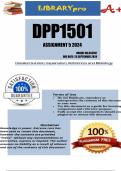DPP1501
ASSIGNMENT 5 2024
UNIQUE NO.843957
DUE DATE: 25 SEPTEMBER 2024
, DPP1501
Assignment 5 2024
Unique Number: 843957
Due Date: 25 September 2024
Diversity, Pedagogy and Practice
Question 1
1.1 Modifying the Curriculum to Accommodate Diverse Learning Styles
A curriculum that supports diverse learning styles recognizes that students absorb,
process, and retain information in different ways. To accommodate these differences,
curricula can integrate multiple teaching methods, such as visual, auditory, and
kinesthetic approaches. For instance, visual learners benefit from diagrams and
infographics, while auditory learners thrive with verbal instruction or discussions.
Kinesthetic learners, on the other hand, need hands-on experiences and physical
activities to grasp concepts better. Incorporating group work, individual tasks, and
various media such as videos and written texts helps engage learners with different
preferences and strengths.
Differentiated instruction is a powerful strategy for addressing diverse learning styles.
This method allows educators to design lessons that meet students where they are,
offering varying levels of difficulty or choice in assignments. Teachers can modify
content, process, and products depending on individual needs, ensuring all learners are
challenged appropriately while maintaining engagement. By scaffolding tasks and
integrating a range of formative assessments, teachers can continuously gauge
understanding and adjust instruction accordingly, making the learning process more
inclusive.
1.2 Modifying the Learning Environment to Accommodate Learners with
Disabilities
, 1.2.1 Accessible Physical Environment
An accessible physical environment ensures that all learners, regardless of mobility
impairments, can navigate the learning space comfortably. This includes features like
ramps, wide doorways, and accessible restrooms. Classrooms should be arranged with
ample space for wheelchair users, while seating can be adjusted to meet the needs of
learners with physical disabilities. Proper lighting and quiet spaces are also critical for
those with sensory sensitivities.
1.2.2 Adaptive Technology
Adaptive technology plays a key role in helping students with disabilities access the
curriculum. Devices such as speech-to-text software, screen readers, or hearing aids
enable learners with visual, auditory, or communication challenges to participate fully in
classroom activities. In addition, assistive tools like alternative keyboards, joysticks, or
tablets can make it easier for students with physical disabilities to interact with
computers and other digital resources.
1.2.3 Flexible Instructional Materials
Flexible instructional materials allow teachers to present information in multiple ways,
accommodating various learning needs. Digital textbooks, for example, can be easily
adapted to include audio options for students with visual impairments or adjusted for
font size and contrast. Teachers can also provide materials in multiple formats, such as
printed handouts, visual aids, or interactive digital platforms, making the content more
accessible.
1.2.4 Alternative Assessment Methods
Alternative assessments cater to students who may struggle with traditional tests and
quizzes due to their disabilities. These can include oral exams, projects, presentations,
or portfolios, allowing learners to demonstrate understanding in a way that suits their




